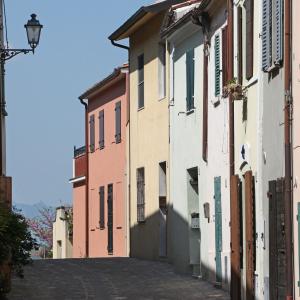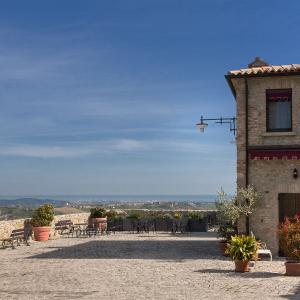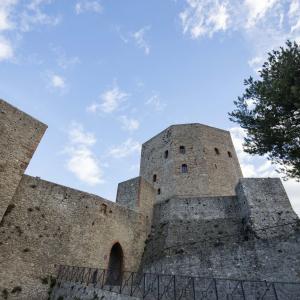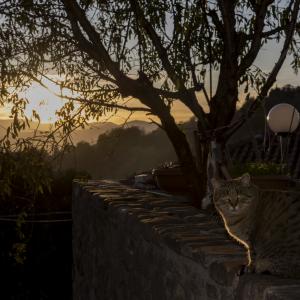An itinerary in the Conca Valley
This itinerary passes through some of the most beautiful villages in the Conca Valley. We are in the midst of history and nature, on the highest terrace stretching from the sea to Montefeltro.
From Montefiore Conca, passing through Montescudo - Montecolombo and the remains of the castle of Albereto, the panorama that alternates the colours of the seasons merges inextricably with the history of the Malatesta family.
For a longer route along the valley of the River Conca follow the indications for Montescudo and Montecolombo. Then, on arrival at the crossroads for Osteria Nuova, turn off and proceed as far as Montefiore Conca.
The Montefiore residence Montefiore Conca is plainly visible from Rimini and all along the coastal plain. It dominates the central Conca and Ventena valleys as the strongest and most coherent link in the Malatesta chain of defence. To comprehend its strategic importance, it is enough to compare this fortress to others in the Montefeltro area such as those at Tavoleto or Sassofeltrio. It is possibly the most characteristic of the Malatesta castles with its prismatic shape, and strange almost surrealistic appearance. No wonder, therefore, that on his travels in the area Giovanni Bellini was struck by its clean-cut geometric aspect, compact and crystalline, to the extent that he portrayed it in the background of at least two of his paintings.
In recent years the castle has been the object of complex operations of consolidation, seismic protection and restoration for the delight of visitors who can now view the older parts of the building, formerly inaccessible. Even in the thirteenth century the building must have already been of considerable size and functional efficiency, with a tower erected slightly apart from a residential palace, both of which were protected by a wall surrounding a courtyard and a cistern situated on top of the hillside.
It is worth a climb up to the highest terrace of the castle from where the visitor will be rewarded by a stupendous panorama stretching from the sea to Montefeltro. In recent years, archaeological research has brought to light a considerable quantity of artefacts, many of which are in excellent condition: several enamelled tankards among the most antique examples in central-northern Italy, fifteenth and sixteenth century ceramics produced in Pesaro and Faenza. During the years when the Malatestas were at the peak of their power, many important personages were guests at the castle: Louis the Great, king of Hungary, Sigismondo, king of Bohemia, Pope Gregory XII, Pope Julius II and others.
Before leaving the historic centre of Montefiore, take a look at the buildings forming a semi-circle below the castle and the parish church with its fine Gothic portal and fourteenth century crucifix of the Rimini school.
Retracing your steps back from Osteria Nuova, proceed on to Montecolombo and then to Montescudo, two well-established centres on the left bank of the river, which (together with Gemmano) were almost destroyed during the last war.
At Montescudo, the imposing walls of the castle, with their large inclined escarpments, could withstand any attack. On the southern bastion a large marble plaque sculpted with the traditionally careful disposition of the words and choice of characters, bears a solemn Latin inscription. In it, Sigismondo relates how he founded and erected this great castle as a protective “shield” for the city of Rimini in 1460. Dominating the centre of the Conca Valley and the torrent valley of the Marano, directly facing the enemy fortifications of San Marino, this fortress was effectively a key element in the Malatesta defence system, truly a protective shield for the city of Rimini, to which it is linked by a convenient road along the ridge, only about twenty kilometres long. On 31st March 1954, during restoration work on the eastern wall of Montescudo, twenty-two medals bearing the effigy of Sigismondo were found. They are part of a famous and truly stupendous series, struck in bronze by Matteo de’ Pasti, around the middle of the fifteenth century. Further similar finds have come to light in other places, concealed inside the walls of Malatesta constructions; we know that the rulers of Rimini used to conceal suchlike articles inside castle walls to preserve the memory of their names and faces even after an eventual destruction of their architectural feats. Certainly, such considerations could not be understood by the common people who told tales about such deposits and thought of them as treasure trove: various legends about treasure hidden inside the walls of Malatesta castles were in circulation even in Sigismondo’s time.
Albereto castle, a construction of ancient origin which was further strengthened by Sigismondo Malatesta, rises just a few kilometres from Montescudo. Recent accurate restoration has enabled it to rank once more as one of the architectural pearls of the Malatesta era. Of note are the typical Malatesta “scarp walls”, three round towers and the bell tower. The ample terrace has an enviable view over the valley to the coast.
Montecolombo has maintained its mediaeval character over the centuries and entrance into the village is made through an embattled gateway in the form of an ogival arch. It came under Malatesta dominion in 1271 and is surrounded by walls and ramparts. In the nearby hamlet of San Savino the restored walls of a small castle dating back to the time of Sigismondo Malatesta can be seen. From Montecolombo, following the indications for Taverna and Santa Maria del Piano, the road leads to the upper Conca Valley as far as Carpegna.
Taken from Castles and Fortresses in the Rimini area. From the Middle Ages to the Renaissance.



